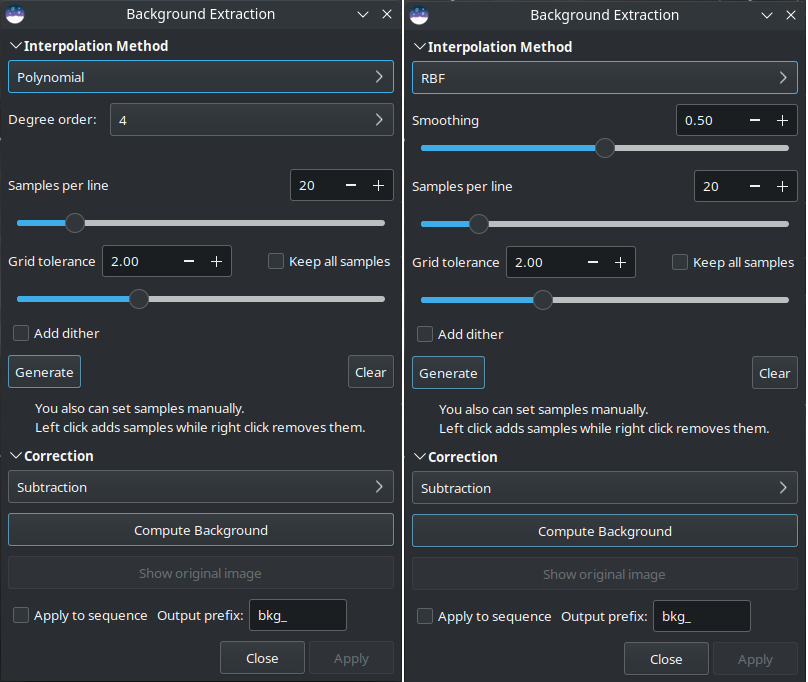Background Extraction
The sky background often has an unwanted gradient caused by light pollution, the moon, or simply the orientation of the camera relative to the ground. This function samples the background at many places of the image and looks for a trend in the variations and removes it following a smoothed function to avoid removing nebulae with it.

Background extraction dialog box. On the left is the polynomial version, on the right RBF.
Samples can be automatically placed by providing a density (Samples per line) and clicking on Generate. If areas of the image are brighter than the median by some factor Grid tolerance times sigma, then no sample will be placed there.
Tip
If you have very strong gradients, for example when imaging in high Bortle urban skies, even the maximum grid tolerance may be insufficient. In this case you can check the Keep all samples checkbox and the full sample grid will be populated. You will then need to remove samples from actual astronomical objects manually.
After generation, samples can also be added manually (left click) or removed manually (right click).
There are two algorithms to remove the gradient:
RBF
This is the most modern method. It uses the radial basis function to synthesize a sky background to remove the gradient with great flexibility. It requires a single parameter which is present in the form of a slider: Smoothing. With this value you can determine how soft or hard the transition between the sample points is calculated. A high smoothing factor makes sense for large and uniform gradients, and a correspondingly lower value for small, local gradations.
Tip
Start with the basic setting (50%) and gradually tweak for optimal results.
Theory
Radial basis functions are functions of the form \(\phi(\mathbf{x}) = \phi(\| \mathbf{x} \|)\), whereby in our case we use the Euclidean norm \(\| \mathbf{x} \| = \sqrt{x_1^2 + x_2^2}\). The function \(f\), which describes the background model, can now be expressed as a linear combination
where \(w_i\) corresponds to the weights for the different sample points and \(o\) corresponds to a constant offset.
The requirement that the function \(f\) should pass through the sample points results in the condition
which can only be fulfilled if the matrix on the left-hand side is invertible. With the right choice of function \(\phi\) this can always be guaranteed [Wright2003].
In addition, the summand \(s \, I\) is added to the matrix on the left-hand side, where \(s\) is a smoothing parameter and \(I\) is the unit matrix. The summand causes a regularization, which results in a smoother result the larger the parameter \(s\) is. This parameter can be changed with the Smoothing parameter of the dialog box.
For the radial basis function, we use the thin-plate spline \(\phi(|\mathbf{x}|) = |\mathbf{x}|^2 \log(|\mathbf{x}|)\).
Polynomial
This is the original and simplest algorithm developed in Siril. Only one parameter is used in polynomial computation: the Degree order. The higher the degree, the more flexible the correction, but a too high degree can give strange results like overcorrection.
Tip
A degree 1 correction can be very useful for when you want to remove the gradient on the subs.
Theory
Polynomial functions are functions of the form
In Siril, the maximum degree allowed is \(n=4\) and can be modified using the Degree order drop-down menu. Beyond this, the model is generally unstable and gives poor results.
General settings
Add dither: Hit this option when color banding is produced after background extraction. Dither is an intentionally applied form of noise used to randomize quantization error, preventing large-scale patterns such as color banding in images.
Correction:
Subtraction: it is mainly used to correct additive effects, such as gradients caused by light pollution or by the Moon.
Division: it is mainly used to correct multiplicative phenomena, such as vignetting or differential atmospheric absorption for example. However, this kind of operation should be done by master-flat correction.
Compute Background: This will compute the synthetic background and will apply the selected correction. The model is always computed from the original image kept in memory allowing the user to work iteratively.
Show original image: Keep pressing this button to see the original image.
The background gradient of pre-processed image can be complex because the gradient may have rotated with the acquisition session. It can be difficult to completely remove it, because it’s difficult to represent it with a polynomial function. If this is the case, you may consider removing the gradient in the subexposures: in a single image, the background gradient is much simpler and generally follows a simple linear (degree 1) function.
Tip
Good results with the RBF algorithm generally require fewer samples than with the polynomial algorithm.
See also
For more explanations, see the corresponding tutorial here.
Siril command line
subsky { -rbf | degree } [-dither] [-samples=20] [-tolerance=1.0] [-smooth=0.5]
Siril command line
seqsubsky sequencename { -rbf | degree } [-nodither] [-samples=20] [-tolerance=1.0] [-smooth=0.5] [-prefix=]
Wright, Grady Barrett. Radial basis function interpolation: numerical and analytical developments. University of Colorado at Boulder, 2003.